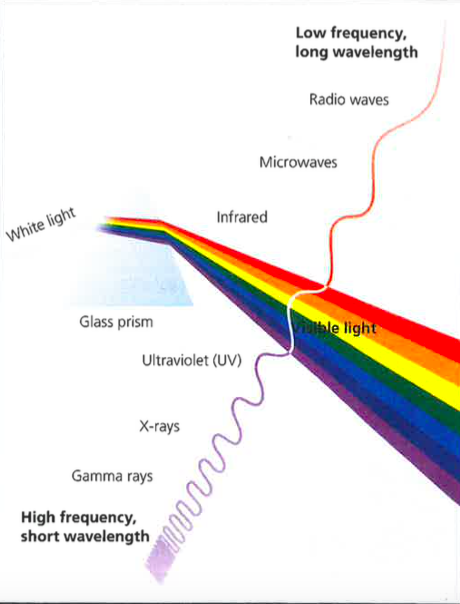Heat Radiation
Introduction
⇒ Heat can be transferred by conduction, convection and radiation
Emitting Electromagnetic Waves
⇒ Heat radiation is also known as infrared radiation - such radiation consists of purely electromagnetic waves of a certain range of frequencies
⇒ Here is the electromagnetic spectrum:

⇒ Infrared radiation, as you can see, is next to visible light
⇒ Everything emits and absorbs thermal radiation. If something is hotter than what is around it, it emits more radiation than it is absorbing. Whereas an object which is colder than what is around it is absorbing more radiation that it is emitting.
⇒ As something gets hotter, the more thermal radiation it will give off.
⇒ For example, stand next to a hot car you can feel the heat radiation it is giving off.
Radiation and the sun
⇒ It is possible for radiation to happen in a vacuum, such as space.
- This is why heat from the sun can reach us
⇒ Heat radiation will only be transferred if it is transparent to infrared radiation - for example, glass, water, and air
⇒ Unlike with conduction and convection, the surface colour and texture of an object will determine the amount of heat radiation that is emitted/absorbed
The amount of heat radiated or emitted will depend on...
1) The surface area of the object
⇒ Heat radiates outwards from an object's surface
⇒ If the surface area is large, more electromagnetic waves can be emitted, so heat is lost quicker
⇒ In addition, if the the surface area is large, more electromagnetic waves can be absorbed, so it will heat up quicker
2) Colour and Texture
⇒ A matt black surface absorbs and emits thermal radiation very well. For example, having a black oven is good as it will help to radiate as much heat as possible
⇒ Objects that are light coloured and smooth are poor at absorbing and emitting thermal radiation. For example, the emergency services sometimes put a shiny blanket on people to keep them warm (the shiny surface reflects their body heat back towards)